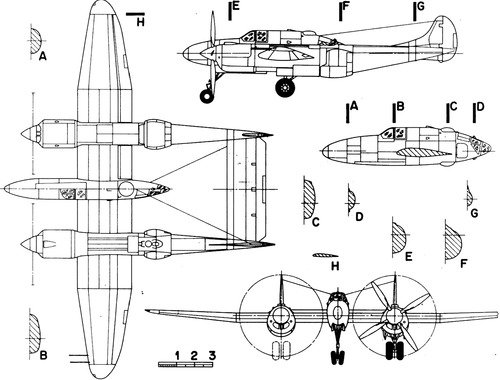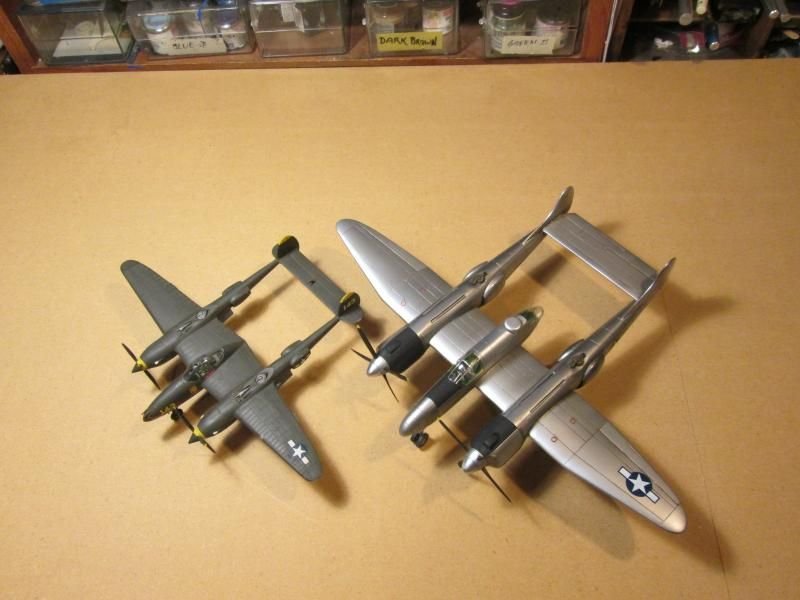- Yes
- No
Note: This suggestion was imported from the old War Thunder forum.
The sole completed XP-58 Chain Lightning during test flight in 1944. Note the “bulge” at the rear of the canopy, this is a dummy turret to be fitted with 2 × 12.7 mm Browning machine guns.
Development of the XP-58 started all the way back into early 1940, by this time, the P-38 Lightning has just entered service with the USAAC. After the USAAC reluctantly agreed to grant the permission for Lockheed to sold the P-38 to the UK and France, on 12 April 1940, the USAAC contracted Lockeed to developed a new aircraft as an improvemed successor for the P-38 to fulfil the same role as the Lightning; long-range fighter/interceptor. Lockheed purposed two designs to the USAAC, the first one is simply a single-seater with the same armaments as the P-38 (one 20 mm AN/M2 cannon and four 12.7 mm Browning MGs), while the second one is a two-seater with an extended canopy to accomodate defensive gunner who controls a two remote-controlled single 12.7 Browning MG located at the end of each tail boom. In May 1940, the USAAC ultimately choose the two-seater design and assigned “XP-58” designation to the plane.
Initially, Lockheed intended to use Continental IV-1430 as the plane’s powerplant. However, during a meeting in July 1940, the USAAC deemed the Continental engine underpowered and change the engine into the then under-development Pratt & Whitney XH-2600 engines. The tail boom turrets were also deemed impractical and were switched into a conventional single remote-controlled dorsal turret with two 12.7 Browning MG.
Shortly after planned engine change, however, Lockheed was informed by the USAAC that the development of the XH-2600 engine has been indefinitely suspended, and that the plane has to be redesigned to fit the new engines. Lockheed initally choose the famous Pratt and Whitney R-2800 “Wasp” radial engine, but the USAAC overruled them as they deemed the engine performance “unsatisfactory” and instead choose yet another under-development Wright XR-2160 “Tornado” which is a smaller yet more complex inline engine for the plane. The decision was finalized in March 1941.
Two months later, the USAAC ordered the plane to be installed with a pressurized cabin for the pilot and gunner, as well as an additional ventral turret to supplementing dorsal turret.
A blueprint of XP-58 Chain Lightning.
Nothing seems to be changed after this and the XP-58 were expected to enter the service in August 1942. However, after the Japanese attack on the Pearl Harbour and with the United States officially joined the World War II. The XP-58 was assigned to a lower priority and most of its engineering staff were moved into more crucial projects, reducing the team working on the XP-58 from 187 people on October 1941 to only 12 by early 1942.
A scale model of the P-38 Lightning compared to the XP-58 Chain Lightning, showing the size difference between two planes.
After the newly-assigned Wright Tornado engines suffered serious development problems and were delayed until 1943. On March 1942, Lockeed requested the USAAC to order a second prototype to increase its fuel capacity and extend its range to meets its requirements. The USAAC agreed and ordered a new prototype in May 1942 using government funds.
Following the order for the second prototype, however, the USAAF would have issued several conflicting main armament changes in an attempt to find a suitable roles for the plane. First by changing its main armament into a single 75 mm M5 cannon and two 12.7 mm Browning MGs to serve as a “tank buster” plane, then changed into six 20 mm AN/M2 cannons to turned it into heavy figher/ground attack aircraft, and even purposed to turn the plane into a frontline bomber by replacing the nose armaments with a bombardier and adding exteral hardpoints for carrying bombs.
Armament scheme for the XP-58 Chain Lightning. Note the “T-9” 75 mm cannon designation, this is a prototype name of what will be later known as M5 cannon.
It was soon realized by the USAAC that their requirements for redesigning the XP-58 into a ground attack aircraft were pointless and redundant, as they have other planes that fulfil these roles prefectly; the Douglas A-26 Invader has entered service and were proven to be a highly capable attacker, while the prototype Beechcraft XA-38 Grizzly shows promising performance as a delicated “tank buster”. So, the USAAC issued yet another reclassification for the XP-58, this time reverted the XP-58 back into its original role as an interceptor. But this time, the USAAC changed its armament to serve solely as a bomber hunter, changing its armaments into four 37 mm M9 cannons. By the time these changes were made (late 1942), however, the threat of bombers were diminished in European and Pacific theatre, the XP-58’s redesigned role as a pure-bred interceptor is now mostly pointless.
With the USAAC constantly changing the plane’s armaments to try to fit the XP-58 into whatever roles they can think of. In January 1943, Lockheed purposed the USAAC to make the nose of the plane interchangeable, so that it can be fitted with either the “tank buster” 75 mm or four 37 mm “bomber killer” armaments.
A next month later, however, the development of the Wright Tornado engines were finally cancelled after troubled development. Both Lockheed and the USAAC then agreed to use the more reliable Allison V-3420 engines. With the final engine changes, the XP-58 prototype is finally completed in June 1944.
The first prototype aircraft were not fitted with pressurized cabin, it has no main armaments, and were fitted with a dummy dorsal and ventral turrets. The prototype made its first flight on 6 June 1944 (the same day as Operation Overlord) from Lockheed Air Terminal at Burban. In its first flight, the plane flew from Burban to Muroc AAC (now Edwards AFB). At Muroc, the plane would made 25 test flight before being transferred to Wright Field, Ohio in 22 October 1944.
The XP-58 prototype suffered from supercharger problem which hampered its performance. The plane is also quite expensive and hard to maintain. Finally, in 1945, the XP-58 project were cancelled after 5 years of troubled development. The first prototype was transferred for use as a non-flying instructional airframe and were persumably scrapped afterwards. The second prototype were left unfinished and also persumably scrapped.
Extra images:
While the XP-58 Chain Lighting was a failure due to development troubles and its constantly changing roles. In War Thunder, it would serve as an archtypical heavy figher with an option of ground-pounding and tank-busting loadouts. Due to its interchangeable nose, you have an option like the A-26B-10 to choose between two armament choice of either a 75 mm cannon and two 12.7 mm machine guns for “tank busting” usage or four 37 mm cannons against aerial threats. While six 20 mm were also proposed, it was dropped early on in favor of four 37 mm cannons so I will not include it here.
Specifications:
General characteristics:
Crew: two, pilot and gunner
Length: 49 ft 5.5 in (15.07 m)
Wingspan: 70 ft 0 in (21.34 m)
Height: 16 ft 0 in (4.88 m)
Wing area: 600 sq ft (55.7 m2)
Empty weight: 31,624 lb (14,344 kg)
Max takeoff weight: 39,192 lb (17,777 kg)
Powerplant: 2 × Allison V-3420 24 cylinder liquid-cooled engine, 3,000 hp (2,238 kW) each
Flight performances:
Maximum speed: 436 mph (702 km/h, 379 kn) at 25,000 ft (7,620 m)
Cruise speed: 283 mph (455 km/h, 246 kn)
Range: 2,650 mi (4,265 km, 2,304 nmi)
Service ceiling: 38,200 ft (11,645 m)
Rate of climb: 2,582 ft/min (13.1 m/s)
Armaments:
Offensive: 4 × 37 mm (1.46 in) M9 cannons (45 rpg in the upper magazine, 35 rpg in the lower magazine, 160 rounds total) or 1 × 75 mm (2.95 in) M5 cannon (20 rounds total) and 2 × .50 in (12.7 mm) Browning heavy machine guns (300 rpg, 600 rounds total) in interchangeable nose
Defensive: 4 × .50 cal (12.7 mm) Browning heavy machine guns in two remotely controlled flexible twin turrets in the rear twin dorsal and ventral turrets (500 rpg, 1,000 rounds per turret total, 2,000 rounds overall)
Suspended: Up to 4,000 lbs (~1,800 kg) of bombs
Sources:
Spoiler
Lockheed XP-58 Chain Lightning - Wikipedia
Francillon, René J. Lockheed Aircraft since 1913. London: Putnam, 1982.
Green, William. War Planes of the Second World War, Volume Four: Fighters. London: MacDonald & Co. (Publishers) Ltd., 1961 (Sixth impression 1969).
Green, William and Gordon Swanborough. WW2 Aircraft Fact Files: US Army Air Force Fighters, Part 2. London: Macdonald and Jane’s Publishers Ltd., 1978.





.jpg.5073cfc8eae00d021040c103595f7132.jpg)
.jpg.7725c6c935acba144565691900d9394f.jpg)
_(4599062096).jpg.7f626c46e4bcaa4c28c99aacbe621452.jpg)
